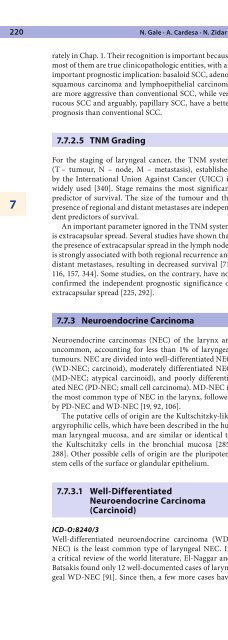Pathology of the Head and Neck
Pathology of the Head and Neck
Pathology of the Head and Neck
- No tags were found...
Create successful ePaper yourself
Turn your PDF publications into a flip-book with our unique Google optimized e-Paper software.
220 N. Gale · A. Cardesa · N. Zidar7ICD-O:8249/3It is <strong>the</strong> most frequent type <strong>of</strong> NEC in <strong>the</strong> larynx, constituting54% <strong>of</strong> all laryngeal neuroendocrine neoplasms,with approximately 300 cases described in <strong>the</strong> literature[106, 242].Similar to o<strong>the</strong>r types <strong>of</strong> NEC, MD-NEC is morecommon in males, with a wide age range from 20 to83 years. The majority <strong>of</strong> patients are heavy smokers. Itarises mostly in <strong>the</strong> supraglottic region. Hoarseness <strong>and</strong>dysphagia are <strong>the</strong> most common symptoms; 20–30% <strong>of</strong>patients also experience pain [19, 243]. MD-NEC is rarelyassociated with carcinoid syndrome [388]. Some paratelyin Chap. 1. Their recognition is important becausemost <strong>of</strong> <strong>the</strong>m are true clinicopathologic entities, with animportant prognostic implication: basaloid SCC, adenosquamouscarcinoma <strong>and</strong> lymphoepi<strong>the</strong>lial carcinomaare more aggressive than conventional SCC, while verrucousSCC <strong>and</strong> arguably, papillary SCC, have a betterprognosis than conventional SCC.7.7.2.5 TNM GradingFor <strong>the</strong> staging <strong>of</strong> laryngeal cancer, <strong>the</strong> TNM system(T – tumour, N – node, M – metastasis), establishedby <strong>the</strong> International Union Against Cancer (UICC) iswidely used [340]. Stage remains <strong>the</strong> most significantpredictor <strong>of</strong> survival. The size <strong>of</strong> <strong>the</strong> tumour <strong>and</strong> <strong>the</strong>presence <strong>of</strong> regional <strong>and</strong> distant metastases are independentpredictors <strong>of</strong> survival.An important parameter ignored in <strong>the</strong> TNM systemis extracapsular spread. Several studies have shown that<strong>the</strong> presence <strong>of</strong> extracapsular spread in <strong>the</strong> lymph nodesis strongly associated with both regional recurrence <strong>and</strong>distant metastases, resulting in decreased survival [71,116, 157, 344]. Some studies, on <strong>the</strong> contrary, have notconfirmed <strong>the</strong> independent prognostic significance <strong>of</strong>extracapsular spread [225, 292].7.7.3 Neuroendocrine CarcinomaNeuroendocrine carcinomas (NEC) <strong>of</strong> <strong>the</strong> larynx areuncommon, accounting for less than 1% <strong>of</strong> laryngealtumours. NEC are divided into well-differentiated NEC(WD-NEC; carcinoid), moderately differentiated NEC(MD-NEC; atypical carcinoid), <strong>and</strong> poorly differentiatedNEC (PD-NEC; small cell carcinoma). MD-NEC is<strong>the</strong> most common type <strong>of</strong> NEC in <strong>the</strong> larynx, followedby PD-NEC <strong>and</strong> WD-NEC [19, 92, 106].The putative cells <strong>of</strong> origin are <strong>the</strong> Kultschitzky-likeargyrophilic cells, which have been described in <strong>the</strong> humanlaryngeal mucosa, <strong>and</strong> are similar or identical to<strong>the</strong> Kultschitzky cells in <strong>the</strong> bronchial mucosa [285,288]. O<strong>the</strong>r possible cells <strong>of</strong> origin are <strong>the</strong> pluripotentstem cells <strong>of</strong> <strong>the</strong> surface or gl<strong>and</strong>ular epi<strong>the</strong>lium.7.7.3.1 Well-DifferentiatedNeuroendocrine Carcinoma(Carcinoid)ICD-O:8240/3Well-differentiated neuroendocrine carcinoma (WD-NEC) is <strong>the</strong> least common type <strong>of</strong> laryngeal NEC. Ina critical review <strong>of</strong> <strong>the</strong> world literature, El-Naggar <strong>and</strong>Batsakis found only 12 well-documented cases <strong>of</strong> laryngealWD-NEC [91]. Since <strong>the</strong>n, a few more cases havebeen described in <strong>the</strong> English-language literature [67,191, 242, 326, 341, 391].Well-differentiated NEC occurs predominantlyin males, <strong>the</strong> average age is 58 years, <strong>and</strong> <strong>the</strong> majority(83%) are located in <strong>the</strong> supraglottis [92]. They presentclinically with dyspnoea, hoarseness <strong>and</strong>/or sore throat.Grossly, laryngeal WD-NEC is typically a submucosalnodule or a polypoid lesion measuring up to2 cm in diameter. Microscopically, like WD-NEC elsewherein <strong>the</strong> body, <strong>the</strong>y are composed <strong>of</strong> small uniformcells growing in isl<strong>and</strong>s, ribbons <strong>and</strong> cords, occasionallyforming gl<strong>and</strong>-like structures. Mucin may occasionallybe present. The nuclei are round, with finelydispersed chromatin <strong>and</strong> inconspicuous nucleoli; <strong>the</strong>cytoplasm is scant, clear or eosinophilic. Mitoses aresparse or absent, <strong>and</strong> <strong>the</strong>re is no necrosis or cellularpleomorphism.Immunohistochemically, laryngeal WD-NEC expressesmarkers <strong>of</strong> neuroendocrine differentiation (suchas chromogranin, synaptophysin, neuron-specific enolase,Leu-7), <strong>and</strong> markers <strong>of</strong> epi<strong>the</strong>lial differentiation(such as cytokeratins <strong>and</strong> epi<strong>the</strong>lial membrane antigen)[106]. Electron microscopy reveals dense-core neurosecretorygranules [91, 106].Differential diagnosis includes moderately differentiatedNEC, paraganglioma, <strong>and</strong> adenocarcinoma, <strong>and</strong> isdiscussed in <strong>the</strong> next section.The treatment <strong>of</strong> choice is complete but conservativesurgical excision. <strong>Neck</strong> dissection is not indicated. Radio<strong>the</strong>rapy<strong>and</strong> chemo<strong>the</strong>rapy have not proven effective[106, 248].The prognosis is favourable, although metastases to<strong>the</strong> lymph node, liver, bones <strong>and</strong> skin have been reportedin one-third <strong>of</strong> patients. Only one patient has died <strong>of</strong><strong>the</strong> disease [91]. These data suggest <strong>the</strong> more aggressivebehaviour <strong>of</strong> laryngeal WD-NEC compared with bronchialWD-NEC, but <strong>the</strong> number <strong>of</strong> patients is too smallto draw any conclusions [19].7.7.3.2 Moderately DifferentiatedNeuroendocrine Carcinoma(Atypical Carcinoid)








